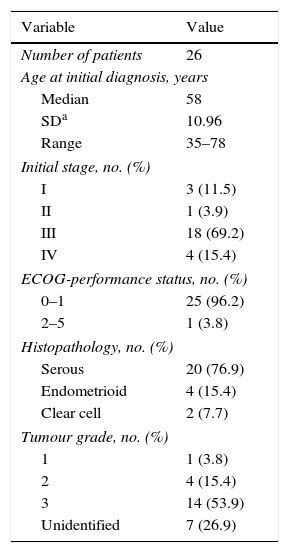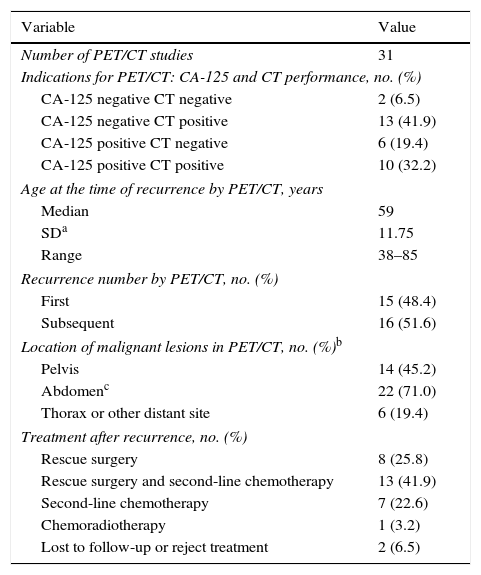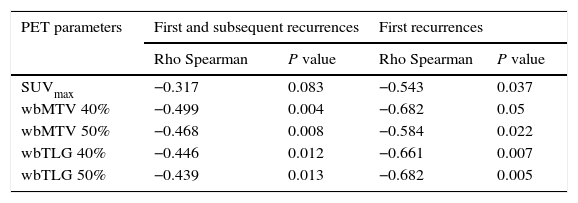Metabolic tumour volume (MTV) and total lesion glycolysis (TLG) from 18F-FDG PET/CT are emerging prognostic biomarkers in various solid neoplasms. These volumetric parameters and the SUVmax have shown to be useful criteria for disease prognostication in preoperative and post-treatment epithelial ovarian cancer (EOC) patients. The purpose of this study was to evaluate the utility of 18F-FDG PET/CT measurements to predict survival in patients with recurrent EOC.
Material and methodsTwenty-six patients with EOC who underwent a total of 31 18F-FDG PET/CT studies for suspected recurrence were retrospectively included. SUVmax and volumetric parameters whole-body MTV (wbMTV) and whole-body TLG (wbTLG) with a threshold of 40% and 50% of the SUVmax were obtained. Correlation between PET parameters and progression-free survival (PFS) and the survival analysis of prognostic factors were calculated.
ResultsSerous cancer was the most common histological subtype (76.9%). The median PFS was 12.5 months (range 10.7–20.6 months). Volumetric parameters showed moderate inverse correlation with PFS but there was no significant correlation in the case of SUVmax. The correlation was stronger for first recurrences. By Kaplan–Meier analysis and log-rank test, wbMTV 40%, wbMTV 50% and wbTLG 50% correlated with PFS. However, SUVmax and wbTLG 40% were not statistically significant predictors for PFS.
ConclusionVolumetric parameters wbMTV and wbTLG 50% measured by 18F-FDG PET/CT appear to be useful prognostic predictors of outcome and may provide valuable information to individualize treatment strategies in patients with recurrent EOC.
El metabolic tumour volume (MTV) y la total lesion glycolysis (TLG) obtenidos de la 18F-FDG PET/TC son biomarcadores pronósticos emergentes en varias neoplasias. Estos parámetros volumétricos junto con el SUVmax son útiles para determinar el pronóstico preoperatorio y post-tratamiento de las pacientes con cáncer epitelial de ovario (CEO). El objetivo fue determinar la utilidad de los parámetros de la 18F-FDG PET/TC para predecir la supervivenvia de las pacientes con CEO recurrente.
Material y métodosSe incluyeron retrospectivamente 26 pacientes con CEO a las que se les realizó 31 estudios 18F-FDG PET/TC por sospecha de recidiva. Se obtuvo el valor del SUVmax, whole-body MTV (wbMTV) y whole-body TLG (wbTLG) con un umbral del 40% y 50% del SUVmax. Se estimó la correlación entre los parámetros PET y el intervalo libre de progresión (ILP) y se realizó análisis de supervivencia segun factores pronósticos.
ResultadosEl subtipo histológico más frecuente fue cáncer seroso (76,9%). La mediana del ILP fue 12,5 meses (rango 10,7-20,6 meses). Se observó correlación inversa moderada entre los parámetros volumétricos e ILP, sin evidenciar correlación significativa con SUVmax. La correlación fue más fuerte para primeras recidivas. Las curvas de supervivencia mostraron correlación entre wbMTV 40%, wbMTV 50% y wbTLG 50% con ILP. SUVmax y wbTLG 40% no fueron predictores de ILP de forma estadísticamente significativa.
ConclusiónLos parámetros wbMTV y wbTLG 50% de la 18F-FDG PET/TC podrían utilizarse como factores pronósticos ofreciendo una valiosa información para individualizar el tratamiento de las pacientes con CEO recurrente.
Artículo

Revista Española de Medicina Nuclear e Imagen Molecular (English Edition)
Comprando el artículo el PDF del mismo podrá ser descargado
Precio 19,34 €
Comprar ahora











